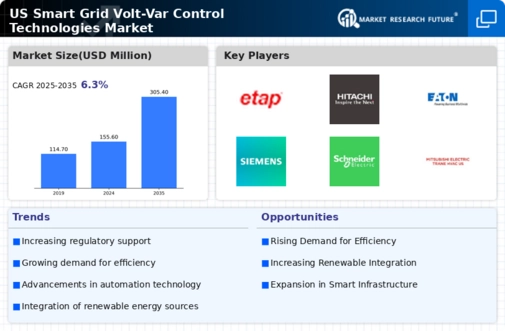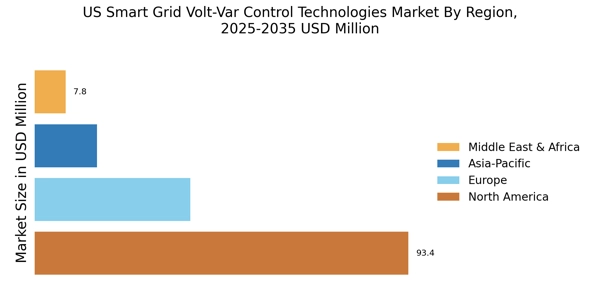Integration of Smart Technologies
The integration of smart technologies into the US Smart Grid Volt-Var Control Technologies Market is a pivotal driver of growth. Smart meters, sensors, and advanced analytics are increasingly being deployed to enhance grid management and operational efficiency. These technologies enable real-time monitoring and control of voltage and reactive power, which is essential for maintaining grid stability. The market is projected to grow significantly, with estimates suggesting a compound annual growth rate of over 15% in the coming years. This integration not only improves reliability but also facilitates the incorporation of renewable energy sources, further driving the demand for Volt-Var control solutions.
Regulatory Framework and Incentives
The regulatory framework surrounding the US Smart Grid Volt-Var Control Technologies Market is evolving to support the adoption of advanced grid technologies. Federal and state policies are increasingly focused on promoting energy efficiency and reducing greenhouse gas emissions. Incentives such as tax credits and grants for utilities that implement Volt-Var control technologies are becoming more common. This regulatory support is crucial for encouraging investment in smart grid infrastructure. As utilities seek to comply with these regulations, the demand for Volt-Var control solutions is expected to rise, thereby propelling market growth. The alignment of regulatory goals with technological advancements creates a favorable environment for the industry.
Increased Demand for Energy Efficiency
The US Smart Grid Volt-Var Control Technologies Market is experiencing heightened demand for energy efficiency solutions. As energy costs continue to rise, utilities and consumers alike are seeking ways to optimize energy consumption. Volt-Var control technologies play a crucial role in managing voltage levels and reactive power, thereby enhancing overall system efficiency. According to recent data, the implementation of these technologies can lead to energy savings of up to 10%. This trend is further supported by the growing emphasis on sustainability and the need to reduce carbon footprints. As a result, the market for Volt-Var control technologies is likely to expand, driven by both regulatory incentives and consumer awareness of energy efficiency benefits.
Growing Investment in Grid Modernization
Investment in grid modernization is a significant driver for the US Smart Grid Volt-Var Control Technologies Market. Utilities are recognizing the need to upgrade aging infrastructure to improve reliability and efficiency. The modernization efforts include the deployment of Volt-Var control technologies, which are essential for managing voltage levels and enhancing grid performance. Recent reports indicate that utilities are expected to invest over 100 billion dollars in grid modernization initiatives over the next decade. This influx of capital is likely to accelerate the adoption of advanced technologies, including Volt-Var control systems, thereby fostering a more resilient and efficient energy grid.
Rising Penetration of Distributed Energy Resources
The increasing penetration of distributed energy resources (DERs) is reshaping the landscape of the US Smart Grid Volt-Var Control Technologies Market. As more renewable energy sources, such as solar and wind, are integrated into the grid, the need for effective voltage and reactive power management becomes paramount. Volt-Var control technologies are essential for accommodating the variability and intermittency of these resources. The market is witnessing a shift towards decentralized energy systems, which necessitates advanced control solutions to maintain grid stability. This trend is expected to drive significant growth in the Volt-Var control technologies sector, as utilities seek to optimize the performance of their grids in the face of increasing DER integration.

















Leave a Comment